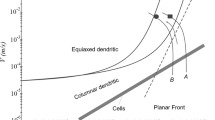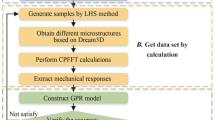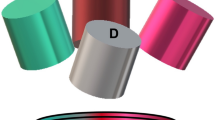Abstract
Micromechanical simulations with an explicit account of the material microstructure provide valuable information on the microscale stress and strain distributions under loading. The construction of 3D microstructure models reproducing realistic microstructure morphology is a challenging task of computational mechanics and materials science. In this paper, a semi-analytical method of step-by-step packing to construct 3D microstructure models of polycrystalline and composite materials is presented. The main idea of the method is to pack a pre-meshed volume with 3D microstructure elements in a stepwise fashion in accordance with a set of geometrical-based algorithms specific for each type of the microstructure. The seed distributions and growth laws are the main parameters controlling the microstructural patterns. It is shown in particular examples that using different growth laws and seed distributions as well as their various combinations it is possible to construct 3D microstructure models with a wide variety of geometrical features. Some aspects of the numerical implementation not addressed before are given in detail.










Similar content being viewed by others
References
Qing H (2015) The influence of particle shapes on strength and damage properties of metal matrix composites. J Nanosci Nanotechnol 15:5741–5748
Gao H (2006) Application of fracture mechanics concepts to hierarchical biomechanics of bone and bone-like materials. Int J Fract 138:101–137
Yadollahpour M, Hosseini-Toudeshky H (2017) Material properties and failure prediction of ultrafine grained materials with bimodal grain size distribution. Eng Comput 33:125–136
Fu SY, Feng XQ, Lauke B, Mai YW (2008) Effects of particle size, particle/matrix interface adhesion and particle loading on mechanical properties of particulate–polymer composites. Compos Part B Eng 39:933–961
Ahmad FN, Jaafar M, Palaniandy S, Azizli KAM (2008) Effect of particle shape of silica mineral on the properties of epoxy composites. Compos Sci Technol 68:346–353
Sharkeev YP, Eroshenko AY, Kovalevskaya ZG et al (2016) Structural and phase state of Ti–Nb alloy at selective laser melting of the composite powder. Russ Phys J 59:430–434
Balokhonov R, Zinoviev A, Romanova V, Zinovieva O (2016) The computational micromechanics of materials with porous ceramic coatings. Meccanica 51:415–428
Fliegener S, Kennerknecht T, Kabel M (2017) Investigations into the damage mechanisms of glass fiber reinforced polypropylene based on micro specimens and precise models of their microstructure. Compos Part B Eng 112:327–343
Romanova VA, Balokhonov RR, Schmauder S (2009) The influence of the reinforcing particle shape and interface strength on the fracture behavior of a metal matrix composite. Acta Mater 57:97–107
Diard O, Leclercq S, Rousselier G, Cailletaud G (2005) Evaluation of finite element based analysis of 3D multicrystalline aggregates plasticity. Application to crystal plasticity model identification and the study of stress and strain fields near grain boundaries. Int J Plast 21:691–722
Chawla N, Sidhu RS, Ganesh VV (2006) Three-dimensional visualization and microstructure-based modeling of deformation in particle-reinforced composites. Acta Mater 54:1541–1548
Diehl M, An D, Shanthraj P et al (2017) Crystal plasticity study on stress and strain partitioning in a measured 3D dual phase steel microstructure. Phys Mesomech 20:311–323
Balokhonov RR, Romanova VA, Martynov SA et al (2016) A computational study of the microstructural effect on the deformation and fracture of friction stir welded aluminum. Comput Mater Sci 116:2–10
Balokhonov R, Romanova V, Batukhtina E et al (2018) A numerical study of microscale plastic strain localization in friction stir weld zones. Facta Univ Ser Mech Eng 16:77–86
Jothi S, Croft TN, Brow SGR (2015) Modelling the influence of microstructural morphology and triple junctions on hydrogen transport in nanopolycrystalline nickel. Compos Part B Eng 75:104–118
Węglewski W, Basista M, Manescu A et al (2014) Effect of grain size on thermal residual stresses and damage in sintered chromium–alumina composites: measurement and modeling. Compos Part B Eng 67:119–124
Weglewski W, Bochenek K, Basista M et al (2013) Comparative assessment of Young’s modulus measurements of metal–ceramic composites using mechanical and non-destructive tests and micro-CT based computational modeling. Comput Mater Sci 77:19–30
Anderson MP, Srolovitz DJ, Crest GS, Sahni PS (1984) Monte Carlo simulation of grain growth in textured metals. Acta Metall 32:783–789
Wang Y, Zhou J, Shen TD et al (2012) Coupled effects of grain size and orientation on properties of nanocrystalline materials. Comput Mater Sci 58:175–182
Ghosh S, Nowak Z, Lee K (1997) Quantitative characterization and modeling of composite microstructures by Voronoi cells. Acta Mater 45:2215–2237
Tran Ph, Ngo TD, Ghazlan A, Hui D (2017) Bimaterial 3D printing and numerical analysis of bio-inspired composite structures under in-plane and transverse loadings. Compos Part B Eng 108:210–223
Vajragupta N, Ahmed S, Boeff M et al (2017) Micromechanical modeling approach to derive the yield surface for BCC and FCC steels using statistically informed microstructure models and nonlocal crystal plasticity. Phys Mesomech 20:343–352
Zinovieva O, Zinoviev A, Ploshikhin V et al (2015) A solution to the problem of the mesh anisotropy in cellular automata simulations of grain growth. Comput Mater Sci 108:168–176
Geiger J, Roósz A, Barkóczy P (2001) Simulation of grain coarsening in two dimensions by cellular-automaton. Acta Mater 49:623–629
Zinoviev A, Zinovieva O, Ploshikhin V et al (2016) Evolution of grain structure during laser additive manufacturing. Simulation by a cellular automata method. Mater. Des. 106:321–329
Song J-H, Fu Y, Kim T-Y, Yoon Y-Ch, Michopoulos JG, Rabczuk T (2018) Phase field simulations of coupled microstructure solidification problems via the strong form particle difference method. Int J Mech Mater Des 14:491–509
Khalevitsky YuV, Konovalov AV (2018) A gravitational approach to modeling the representative volume geometry of particle-reinforced metal matrix composites. Eng Comput. https://doi.org/10.1007/s00366-018-0649-8
Ramin B, Yichi Zh, Xiaolin L et al (2018) Computational microstructure characterization and reconstruction: review of the state-of-the-art techniques. Progr Mater Sci 95:1–41
Bargmann S, Klusemann B, Markmann J et al (2018) Generation of 3D representative volume elements for heterogeneous materials: a review. Progr Mater Sci 96:322–384
Romanova V, Balokhonov R, Makarov P et al (2003) Simulation of elasto-plastic behavior of an artificial 3D-structure under dynamic loading. Comput Mater Sci 28:518–528
Romanova VA, Soppa E, Schmauder S, Balokhonov R (2005) Mesomechanical analysis of the elasto-plastic behavior of a 3D composite-structure under tension. Comput Mech 36:475–483
Romanova VA, Balokhonov RR (2012) Numerical analysis of mesoscale surface roughening in a coated plate. Comput Mater Sci 61:71–75
Balokhonov RR, Romanova VA, Panin AV, Kazachenok MS (2017) Computational mesomechanics of titanium surface-hardened by ultrasonic treatment. Phys Mesomech 20:334–342
Romanova V, Balokhonov R, Schmauder S (2011) Three-dimensional analysis of mesoscale deformation phenomena in welded low-carbon steel. Mater Sci Eng A 528:5271–5277
Romanova V, Balokhonov R, Makarov P (2006) Three-dimensional simulation of fracture behavior of elastic-brittle material with initial crack pattern. Int J Fract 139:537–544
Hansen GA, Douglass RW, Zardecki A (2005) Mesh enhancement. Imperial College Press, London
Fish J, Belytschko T (2007) A first course in finite elements. Wiley, New York
Panin AV, Kazachenok MS, Romanova VA, Balokhonov RR, Kozelskaya AI, Sinyakova EA, Krukovskii KV (2018) Strain-induced surface roughening in polycrystalline VT1-0 titanium specimens under uniaxial tension. Phys Mesomech 21:249–257
Kovalevskaya ZG, Ivanov YF, Perevalova OB et al (2013) Study of microstructure of surface layers of low-carbon steel after turning and ultrasonic finishing. Phys Met Metallogr 114:41–53
Brandt M (2017) Laser additive manufacturing: materials, Design, technologies, and applications. Woodhead Publishing, Cambridge
Acknowledgements
This study has been supported by the Russian Science Foundation through the Grant no. 18-19-00273.
Author information
Authors and Affiliations
Corresponding author
Additional information
Publisher's Note
Springer Nature remains neutral with regard to jurisdictional claims in published maps and institutional affiliations.
Rights and permissions
About this article
Cite this article
Romanova, V., Balokhonov, R. A method of step-by-step packing and its application in generating 3D microstructures of polycrystalline and composite materials. Engineering with Computers 37, 241–250 (2021). https://doi.org/10.1007/s00366-019-00820-2
Received:
Accepted:
Published:
Issue Date:
DOI: https://doi.org/10.1007/s00366-019-00820-2




